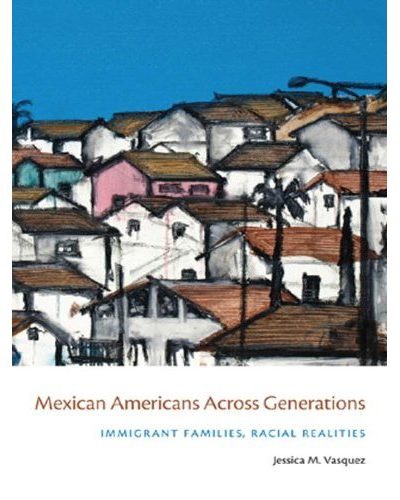 Author: Jessica M Vasquez
Author: Jessica M Vasquez
Publisher: New York University Press
Book Review by: Nano Khilnani
Jessica M. Vasquez, an assistant professor of sociology at the University of Kansas, best describes the scope and purpose of this book. Let me quote her from her Preface: “This book is an academic research endeavor that seeks to discover the social influences that shape the way Mexican Americans, over family generations, experience and explain their social identities.”
She authored this book based on interviews of people from three generations of Mexican-American families living in California: those who immigrated here, their children born here, and their grand children. In the book, these three generations have been compared respectively to Coca Cola, Seven Up and Evian bottled water.
She gathered material for this book by questioning them on issues such as assimilation with the first immigrants or mainstream Americans (who migrated from Europe) and racial identity.
In her Preface, she points out that when she gives presentations on her research, she is often asked, as a Mexican American, where she falls in the spectrum in terms of the “strength of her knowledge of, and commitment to the Mexican heritage,” with the left end of that spectrum being ‘thinned attachment’ and the right end being ‘cultural maintenance’
Describing herself – with English being her first language, having a Princeton University education, a holder of a Ph.D., and being a college professor – she writes that she is “a product of, and deeply embedded in America’s educational system.” So, she adds: “I am unquestionably American”
But she took Spanish classes in high school, cooks Mexican food, and focuses on Latinos as her main research subject. So she qualifies that she too, like most Mexican-Americans, “exist somewhere in the middle of these conceptual categories,” referring to ‘thinned attachment’ and ‘cultural maintenance’.
From her research, Jessica M. Vasquez found that the family was a key factor for the degrees of assimilation (or lack thereof) with mainstream Americans. The family was also key to the formation of personal, gender, group and racial identities, as well for the transmission of knowledge between generations. She also found that racial identities both change and persist from generation to generation in Mexican-American families.
Her studies show that among others, the following influences affected the degrees of their assimilation: personal and family experiences of racial discrimination, gender, historical eras, parental teaching, and physical appearance. But she cautions that neither assimilation nor racial identity occur in a straightforward, even way but rather unevenly because of the influence of family, society and social movements.
From my own observations, who the younger and newer generations of Mexican-Americans identify with and to what degree depends on the level of influence their parents have over them. Whether they identify themselves more with their native Mexican heritage or with Americans depends on the amount of time they spend with their parents or with their classmates in school or with their friends in their social circles.
Acquisition of education and elevation to middle class occupations led to reduced attachment to their culture and traditions for some, but not most Mexican-Americans, Vasquez found. But she points out that many of them still closely identify to their culture and identity as Mexicans, despite their socio-economic mobility.
The research findings showed that racialization, even with assimilation among a segment of the second and third generations, affirm the continuing role of race even among the U.S.-born. The author’s interviews also found that there still exist for Mexican-Americans, numerous barriers and obstacles to assimilation.
If you hope to understand well enough America’s largest ethnic group – Miexcan Americans – and their range of attitudes, behaviors, ideologies, lifestyles, pains, and much more, this book is a must-read.







